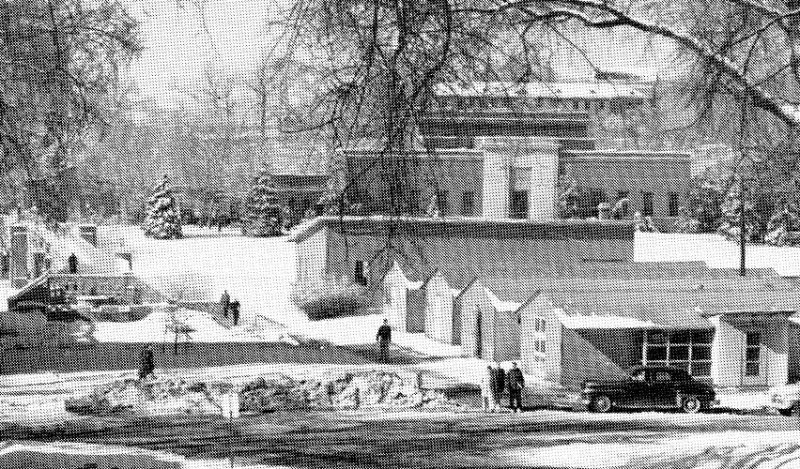Saturday Postcard 212: The Fine Arts at Iowa

Writers’
Workshop occupied the nearest of the temporaries in this 1958 image of what
now is the site of the
University of Iowa’s Advanced Technologies Labs. The Union footbridge, 1934
Art Building and Law Commons
are still recognizable today. The non-extant Fitzgerald Boathouse occupies the
Iowa River bank beyond the four temporaries.
|
By
Bob Hibbs
The
impacts on Iowa City and the UI campus were enormous, creating demands for
classroom and housing space unparalleled before or since. Whole departments
were moved into temporary teaching space, and student families lived in
temporary housing which persisted into the 1970s.
Rows
of trailer houses, 128 units in all called Hawkeye Trailer Village, lined the
Iowa River bank between Iowa Avenue and Burlington Street on what had been
UI’s Athletic Park before Kinnick Stadium was built in 1929.
Classroom
temporaries were located as far east as the Iowa Avenue and Clinton Street
corner now occupied by UI’s Phillips Hall.
The
largest quantity of the metal buildings were divided into a pair of
two-bedroom married-student housing units grouped in “parks” scattered in
open areas on campus. Largest was Finkbine Park located on a site now occupied
by the Dental Building, its parking lot and the athletic facilities across
what is now Hawkins Drive.
Barracks
near Currier Hall were called “Currier Cottages,” softening the name a
bit. The area now serving Hancher, the Music Building and Art Museum served
temporary communities named Riverside, Templin, Quonset and North parks. If
you were married, you could rent a two-bedroom unit whether you had one child
or a dozen.
During
the early 1950s, the units rented at $15 to $20 monthly, including utilities;
and were about $50 monthly in the middle 1960s.
The
most notorious classroom temporary rested along the Iowa River immediately
north of the Iowa Memorial Union.
It
was made so by students in the heralded UI Writers’ Workshop who reported in
published materials that the temporary nearest Madison Street had but one
toilet which flushed using steaming hot water. It was the brunt of jokes from
coast to coast, but mainly in such local watering holes as George’s Buffet
and Bernies Fox Head.
Among
noted faculty and students from that era were Vance Bourjaily, Robert Penn
Warren, Kurt Vonnegut, John Irving, John Cheever and W.D. Snodgrass. From 1937
until his death in O’Hare Airport of a heart attack in 1991, Paul Engle was
a continuous faculty member, heading the workshop during much of that time.
The
UI fine arts programs sprang to national attention during the 1930s by
accepting plays, sculptures, music compositions, paintings, books and other
works of art in fulfillment of thesis requirements for advanced degrees, the
first major institution to do so.
In
the arts community nationally, there became two recommended places for an
aspiring artist to go – New York or Iowa City.
The
university also benefited from the 1930s make-work program which granted funds
to assist in building a half-dozen major UI structures including the Art
Building and University Theatre. It didn’t hurt that the federal Works
Progress Administration which doled out the funds was headed by Iowan and
Grinnell College graduate Harry Hopkins.
A
family connection for this reporter is sister Lilith, a painter who received
her BA in art at UI in 1950 before the degree name became bachelor of fine
arts or BFA. She earned her livelihood developing computer systems for
Employers Insurance of Wausau.
The
Day House on North Clinton Street and nearby Shambaugh House now headquarter
the writing programs, and arts facilities line the west bank of the Iowa River
from Art to Hancher. A major Art expansion is currently underway.
The
fine arts represent the left hemisphere of the UI intellectual being, a rare
thriving counterbalance to the right hemisphere represented by the array of
professional colleges at Iowa, making it a truly remarkable institution.
Next
Saturday: The pioneer money
problem: none in circulation.
Bob
Hibbs collects local postcards and researches history related to them. |